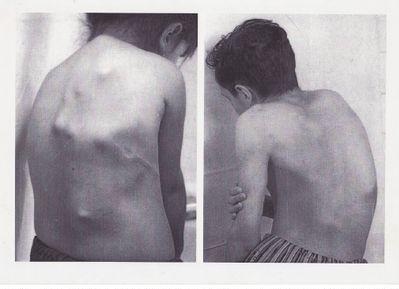How is the treatment of kyphoscoliosis 1, 2, 3, 4 degrees
Kyphoscoliosis – a disease involving the excessive severity of thoracic curvature of the spine (kyphosis) and displacement of its axis in the lateral plane (scoliosis). This combination of deformations leads to some specific symptoms that differ from classic hyperkyphosis and scoliosis.

disease Classification
To assess the severity of the disease, in medicine, applies his classification by degrees:
- Kyphoscoliosis of 1 degree is accompanied by a slight displacement of the axis of the spine (angle of 45-55 degrees) with a slight twisting of the vertebrae (rotation);
- Kyphoscoliosis 2nd degree is characterized by the angle of curvature of 55 to 65 degrees and convoluted swing axis of the vertebral column;
- 3 degree leads to a visible deformation of the thorax and vertebral hump appearance;
- Kyphoscoliosis 4 degrees accompanied by a pronounced curvature of the spine with an angle of curvature of more than 75 degrees.
depending on the direction of curvature there may be 2 types of the disease:
- Driver
- Left.
Causes curvature of the spine
depending on the etiological factor we distinguish the following types of pathology:
- Congenital
- Acquired.
Congenital kyphoscoliosis 2 degrees can be detected immediately after birth. It occurs because of abnormalities of the vertebral arches of violation of transformation of cartilage to bone (osteochondropathy), weakness of the back muscles (mediagiraffe, myopathy). Usually, stage 1 of the disease passes unnoticed, as a special external deformations of the vertical axis of the torso forms. Only when the child turns a few months can be suspected curvature of the spine by asymmetric location of the vertical axis of the body. In practice, doctors were detecting kyphoscoliosis 3 degrees immediately after birth, which is associated with fetal malformations of the skeletal system. Acquired kyphoscoliosis is classified for reasons on:
- Rachitic – with a lack of vitamin d Manifests itself in a few months after birth, when the spinal curvature reaches 2 degrees;
- Nerve – is formed due to poliomyelitis or cerebral palsy (CP);
- kyphoscoliosis accompanies Habitual bad posture
- Rheumatic type is the result of cartilage damage antibodies anti-rheumatic;
- Dysplastic – appears on the background of the disproportionate growth of bone and muscle systems.
Sudden-onset pathology of the spine 2 or 3 level in children aged 14-15 years often formed for no apparent reason. This type is called idiopathic. A harbinger of its occurrence is the scoliosis (lateral curvature of the spine) if landing behind a school Desk or carrying a heavy portfolio. The high children, the pathology is formed on the basis of psychological characteristics. They slouch because I want to be the following (compare growth with their peers).
General symptoms
When the disease of the 2nd degree one of the symptoms is shortness of breath. It appears due to the decrease in volume of pulmonary tissue by reducing the mobility of the thorax on a background of spinal deformity. Other symptoms of kyphoscoliosis 2, 3 degree:
- Pain in the back;
- Disorders of cardiac activity;
- Incontinence
- fatigue
- Loss of sensation in the lower extremities.
Running stage of the disease (grade 3 and 4) lead to disability. It appears due to the violation mobility of the chest, infringement of the nerve roots in the spinal cord. To prevent the development of disability upon the slightest suspicion of deformity of the spine, doctors prescribe x-ray examination. It involves the implementation of functional radiographs in the supine position, after standing and stretching of the spinal column. To clarify the diagnosis assigned to magnetic resonance and computed tomography.
How to treat the disease
Treatment of disease based on the level of severity of pathological changes of other organs. When the curvature of the spinal column 1,2 the degree of focus is to create a strong muscular corset back to support the spine axis in a vertical position.
List of procedures: physiotherapy, massage, acupuncture, physical therapy. Deformation of the spine is 3.4 degrees require treatment by surgery. It is carried out to restore the correct position of the vertebrae. For these purposes, use special metal rods, which is fixed corrupted Department in the physiological position. After the operation some time, the person should walk in the gypsum. Dysplastic kyphoscoliosis requires the restoration of a proportional relationship between bone and muscle system. To this end, the orthopedist-the traumatologist picks up reinforcing the complex gymnastics.Indications for surgical treatment:
- Low efficiency of conservative treatment with persistent pain syndrome;
- Fast progression of the disease with high probability of formation of intervertebral hernia;
- Cosmetic defects back;
- Strong curvature, hindering the functioning of the cardiovascular and respiratory systems.
In most cases, the disease responds well to treatment to 12 years, while there has been a significant growth of the vertebrae. With early detection in children, kyphoscoliosis 1 and 2 degrees can be cured during the year. In some situations, doctors can even get rid of the curvature of 3 degrees without surgical intervention.
To prevent the development of this pathology it is necessary to respect the following recommendations:
- do Not carry heavy bag and briefcase on one shoulder;
- Sleep on a firm mattress
- Maintain proper posture when sitting, walking and even when performing physical activities;
- Daily exercise.













